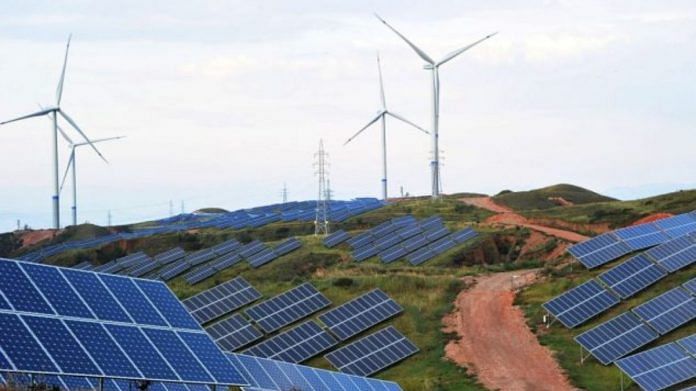New Delhi: India crossed the 100-gigawatt (GW) mark of installed renewable energy capacity Thursday, according to a statement by the Government of India, bringing it one step closer to its renewable energy targets.
“The total installed renewable energy capacity in India, excluding large hydro, has crossed the mile-stone of 100 GW. Today India stands at 4th position in the world in terms of installed RE capacity, 5th in solar and 4th in wind in terms of installed capacity,” the Ministry of New and Renewable Energy said in a statement.
The Narendra Modi government had set an initial target of installing 175 GW of renewable energy capacity, including wind, solar, and hydro, by 2022. It increased this target later to 450 GW by 2030.
“While 100 GW has been installed, 50 GW is under installation and 27 GW is under tendering. India has also enhanced its ambition to install 450 GW of renewable energy capacity by 2030. If large hydro is included the installed RE capacity increases to 146 GW,” the statement said.
The announcement comes days after the Intergovernmental Panel on Climate Change (IPCC) released a damning report on the state of global warming across the world. “Many changes due to past and future greenhouse gas emissions are irreversible for centuries to millennia, especially changes in the ocean, ice sheets and global sea level,” it said.
India’s renewable energy targets mark a shift from its reliance on fossil fuels, which emit large amounts of carbon dioxide.
Also read: How this IIT-Madras grad is pushing battery tech in US that could power passenger planes
India’s green goals
In the 2015 Paris Agreement, India pledged to generate 40 per cent of India’s power through renewable energy, and create a carbon sink capable of absorbing 2.5 billion-3 billion tonnes of carbon dioxide through additional forest and tree cover.
It also made a commitment to reduce greenhouse gas emissions by 33 to 35 per cent of its intensity of GDP below 2005 levels. However, India has resisted pressure from the West to cut down its emissions to net zero, saying it is an unfair demand.
In its report, the IPCC said temperatures would continue to rise well above the 2 deg Celsius limit (above pre-industrial levels), “unless deep reductions in CO2 and other greenhouse gas emissions occur in the coming decades”.
In a statement on 9 August, the government said the report “vindicated” India’s position that “historical cumulative emissions” were the source of the world’s warming climate, and said it was well on its way to achieving its 2015 Paris Agreement goals.
The government added it had taken many measures to reduce emissions, such as, “setting up of International Solar Alliance, Coalition for Disaster Resilient Infrastructure, raising the domestic renewable energy target to 450 GW by 2030 and putting in place an ambitious National Hydrogen Mission and continuing efforts to decouple its emissions from economic growth”.
Also read: Bet on companies that’ll benefit from Modi govt’s infrastructure focus, DSP says



